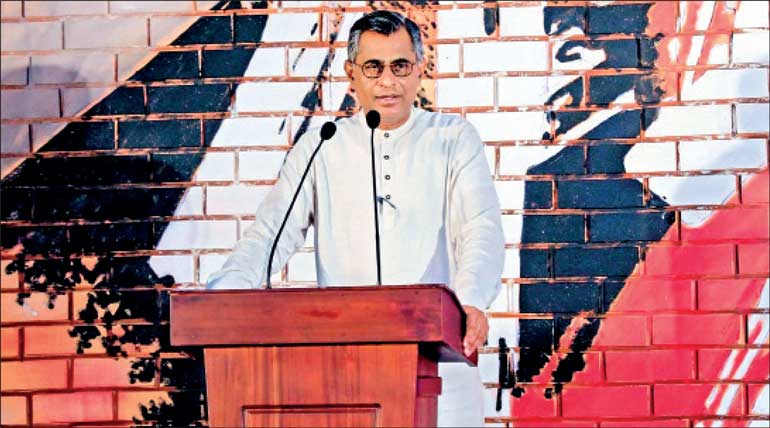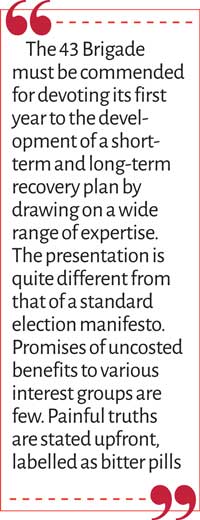Monday Apr 21, 2025
Monday Apr 21, 2025
Friday, 28 January 2022 00:00 - - {{hitsCtrl.values.hits}}

43 Brigade leader Patali Champika Ranawaka
The plan made public on the first anniversary of the 43 Brigade devotes 32 pages to the immediate response to the crisis (entitled “Rescue”) and 26 pages to long-term solutions (entitled “Thrive”), signifying the greater weight assigned to the immediate crisis response. The document is presented as an “initial set of ideas which will lead to a social discourse that brings about a progressive shift in both politics as well as policy formulation.” It is the beginning of a conversation, not the end.
signifying the greater weight assigned to the immediate crisis response. The document is presented as an “initial set of ideas which will lead to a social discourse that brings about a progressive shift in both politics as well as policy formulation.” It is the beginning of a conversation, not the end.
Broad consultations appear to have been conducted. There is evidence the authors have modified their views on some matters over the course of its preparation. The sophistication of the analysis indicates the incorporation of the views of a broad range of experts, beyond a few trusted, close associates as is usual with these kinds of exercises.
Part 1: Remedies for the debt crisis
The efficacy of a remedy depends on accuracy of the diagnosis. The 43 Brigade’s diagnosis, supported by extensive data, is that the current difficulties in managing external debt have been caused by commercial debt taken for non-revenue-yielding projects by the previous Rajapaksa administrations, aggravated by the ill-considered tax cuts of December 2019. The systemic weaknesses caused by the twin deficits that have plagued the Sri Lankan economy since Independence are also recognised.
Bitter pills
The need to restructure the debt, within the framework of an IMF intervention or otherwise, is explicitly recognised: “It is unavoidable that we will have to swallow a bitter pill of stringent economic discipline and restrictions. It could come as a ‘Washington bitter pill of IMF’ or we could generate our own local bitter pill.”
Artificially controlling the exchange rate is seen as impractical and unwise: “Instead of artificially controlling imports and introducing a rationing system, free import under current exchange rates must be allowed.”
Formula-based pricing for fuel and utility services that will be affected by the above actions is proposed: “After a thorough and rigorous public discussion, establish an automatic pricing formula for fuel, electricity, gas and water while mandating a balance score card system that will ensure efficiency, transparency and productivity of the agencies involved in the provision of these utilities.”
All three actions will result in increased retail prices.
Safety net
Upfront acknowledgement that pain will have to be endured sets apart this document from the usual feel-good manifestoes. The ensuing discussions must include immediate policy actions can be taken to at least partially shield the most vulnerable segments of our society from the pain that all will have to endure.
endure.
It is commendable that the ripple-through effects of formula-based pricing on electricity, gas, and water are recognised. When utility services are brought under formal regulation and priced in ways that reflect actual costs, those in the lower deciles of income distribution will be grievously affected. They must be assisted through targeted subsidies dispensed as part of the social safety net described below, as described in an article published last December:
“The ongoing consolidation of multiple overlapping welfare schemes under the Welfare Benefits Board and its beneficiary database must be fast-tracked. Because the depreciation of the rupee will continue for some time resulting in increasing prices for essential items and because utility prices will be volatile, it is necessary to mobilise funds from the ongoing World Bank funded Social Safety Nets Project and develop a mechanism to transfer assistance in targeted manner. High priority to the implementation of a social safety net will help manage the pain. If in the process, the national government can shut down some superfluous entities such as the Samurdhi Department (which consumes 25 percent of the total allocation for the scheme), it will send a powerful message to debt holders.”
It is not that the document ignored the safety net. Changes to Samurdhi and other welfare/subsidy schemes are included in Part 2, “Thrive.” But it is important to understand that the immediate actions to rescue the economy must be accompanied by immediate actions to cushion the pain that will be visited upon the weakest in society.
Winning back confidence
The document correctly states that it is essential to win back the confidence of the market, namely current and future creditors and investors. The proposed actions are good, but lack communicative power.
We do not have the luxury of awaiting the reports of management audits on each of the money guzzling state enterprises. Even though it is not explicitly mentioned in the document, 43 Brigade leader Patali Champika Ranawaka said in his speech that it was no longer possible to continue to throw public money down the pit known as SriLankan Airlines. Putting the national airline on the auction block will attract the attention of international media and convey a powerful message of a country serious about getting its house in order.
Good governance
Improving Sri Lanka’s international image is seen as an essential element of the rescue plan. Here, the very first action that is proposed is the rescinding of the 20th Amendment and restoring the integrity of the key institutions such as the judiciary, the police, and the Elections Commission. Interestingly, even the abuse of the Prevention of Terrorism Act is mentioned. All supporters of the rule of law should be heartened by these proposals, though there may be differences about the rationales.
Addressing the fiscal deficit
The actions to address the fiscal deficit are good, but could be improved. For example, it is one thing to say the massive tax cuts of December 2019 were unwise. It is quite another to propose the immediate reversal of those cuts amidst a crisis when many who will have to pay the increased taxes are on the verge of going under. Taxes will have to be increased, but in a careful and gradual manner.
The revenue increasing proposals are too ambitious; the expenditure reducing proposals are too timid.
When over 70% of state revenues go for salaries and pensions, there is no alternative to reducing that burden. Specific commitments must be made to freeze the growth of state employment and, indeed, to downsize by actions such as the closure of the Samurdhi Department as mentioned above. Samurdhi Niladharis are eating up a lion’s share of welfare expenditure because they are supposed to be teaching the beneficiaries to stand on their own feet. That objective can be better served by asking them to demonstrate successful entrepreneurship using the severance payments as capital.
Part 2: Actions to thrive
Much thought has been given to long-term actions necessary to create an economy that is worth living in: “the more successful method of wealth creation is an open market economic system.” The considered rejection of state socialism, citing Cuba, North Korea, and Venezuela, has created heartburn among the leftists still dominating discourse in Sinhala intellectual circles. The initiation of this discussion is praiseworthy, but need not take up precious space here.
Provincial Councils
Given the past association of the leaders of the 43 Brigade with nationalistic views and organisations, it is noteworthy that the document accepts the 13th Amendment and the devolved governance arrangements imperfectly implemented as a result:
“The present practical constitutional agreement that relates to the aspirations of Sinhala and Tamil politics is the provincial council system. Like it or not, that is the truth. What the Sinhala population must realise is that on one side, considering national and international factors, there is no possibility of reducing the powers of the provincial councils and that the last three decades have clearly shown that the country cannot be divided by the provincial council system. Therefore, instead of being hoodwinked by the false claims of illegitimate patriotism, the Sinhalese population must act intelligently while the Tamil population must be ready and willing to accept this agreement.”
politics is the provincial council system. Like it or not, that is the truth. What the Sinhala population must realise is that on one side, considering national and international factors, there is no possibility of reducing the powers of the provincial councils and that the last three decades have clearly shown that the country cannot be divided by the provincial council system. Therefore, instead of being hoodwinked by the false claims of illegitimate patriotism, the Sinhalese population must act intelligently while the Tamil population must be ready and willing to accept this agreement.”
Here, I would propose that we go beyond simply accepting the status quo, but make the Provincial Councils more effective by, for example, restoring the revenue sources specified in the 13th Amendment that have been unfairly taken away. But it is important to appreciate how far the leaders of the 43 Brigade have come to publicly espouse the above position and appreciate the pressures they must be under from some of their constituencies.
The acceptance of devolution by the 43 Brigade is a major step. Aside from the inherent value of the principle of subsidiarity, it is worth highlighting that inter-ethnic trust and harmony are essential preconditions for the kind of economic. Singapore would never have reached first-world status had the ruling party not succeeded in ensuring inter-ethnic harmony.
Economic policy
The market economy is seen as the only method of creating wealth in order to equitably share it: “our issue is not a welfare problem but rather, the inability of creating wealth that can be shared in the first place.”
Even in areas such as agriculture, where state direction and subsidies have been ingrained over decades, primacy is given to market forces: “In order to protect consumers and farmers, instead of fixed price controls, improve the availability of market data and encourage small scale farmers to organise as cooperatives. The state must intervene only if the market mechanism fails.”
The state is given a market shaping role, by facilitating the provision of market data and creating viable economic actors through cooperatives. This is realistic if the massive yet dysfunctional state machinery in the agricultural sector can be so repurposed and motivated.
The real challenge comes with the industrial policy elements that are proposed for the critically important externally oriented economic sectors, including but not limited to agriculture. There is no long-term solution to Sri Lanka’s crisis short of greater exports.
The vaunted development state that existed in Korea and the other Asian Tigers in the 1960s and 1970s that serves as the model faced a very different world economy from what exists today. Then average tariff levels were high; trade agreements were few and less binding. Exports were of relatively simple (compared to today) manufactured goods where most of the production activities occurred within one or a few countries.
Today’s economy is dominated by global production networks within which large numbers of economic actors located in multiple countries contribute individually small portions of value. The Sri Lankan-Australian economist Prema-chandra Athukorala has made extensive efforts to explain the new economic reality to Sri Lankan audiences, but we appear to have difficulty in escaping from the old mindsets.
In these dynamic and knowledge-infused production networks, the relationships and the trust that has been built up by key entrepreneurs and nimble firms are critical. Exports in these networks are fundamentally dependent on imports. At Lanka Harness, a Sri Lankan company that produces precision sensors to air bags and related equipment in high-end automobiles, pretty much all the raw material that goes into the sensors is imported and the portion of the value of the end product that is contributed by the Sri Lankan firm is minuscule. Yet, because of the scale of operations, the company is extraordinarily successful.
State functionaries, however well-meaning and competent, are not likely to be able to pick winners like Lanka Harness. The quality of our officials has atrophied to such low levels that it is unrealistic to expect such performance from them. More realistic are broad actions to remove obstacles to export as envisaged in the National Export Strategy, and then to provide additional incentives for high performing exporters, as permitted by the relevant trade agreements.
Statements such as “we can no longer attract investments by making production factors profitable for them” indicate the authors of the document are on the right track, despite some minor quibbles such as those above. The recognition that old style industrial parks are no longer relevant, and that primacy must be given to attracting firms that give primacy to innovation and knowledge is on point, though one could argue against the inclusion of business process outsourcing (BPO) businesses within that category.
Next steps
The 43 Brigade must be commended for devoting its first year to the development of a short-term and long-term recovery plan by drawing on a wide range of expertise. The presentation is quite different from that of a standard election manifesto. Promises of uncosted benefits to various interest groups are few. Painful truths are stated upfront, labelled as bitter pills.
It is hoped that all those who care for the future of Sri Lanka participate in the discussion initiated by the 43 Brigade. Legitimate doubts may exist about whether the fine sounding words will be implemented in the right spirit. The solution to that problem is not the rejection of the ideas; it is in the setting in place of a mechanism to ensure the finally agreed upon common program is honestly implemented. That is a subsequent conversation.